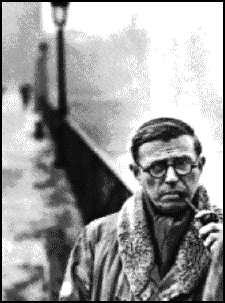Jean-Paul Sartre
Roudinesco begins by situating Huston's choice of Sartre as screenwriter within the context of America's hygienisation, medicalisation and corruption of psychoanalysis. Apparently, the one oasis in America "where emigrants from old Europe sustained the 'high tradition' of Freudian analysis was Hollywood, which Roudinesco represents as a European-operated machine for 'criticising the ideals of the American way of life." Huston, although an American --- or 'American born,' as Roudinesco charitably puts it --- decided to make a movie about this Freud: the European, anti-American one.
Another way of looking at it would be to say that Huston, following the great American biopic tradition, wanted to make a movie about how Freud became Freud. But in either case Sartre, the pre-eminent and ultra-European philosopher of becoming, was an ideal choice. He completed a 95-page screen treatment in 1958. The protagonist of Sartre's script was Freud the young neurologist, who had reached a 'desperate impasse' in his treatment of Anna O and in his theory of the sexual etiology of hysterical neurosis. For the part of Anna O, incidentally, Sartre had his eye on Marilyn Monroe, who was discouraged from taking the role by Anna Freud and by Monroe's own psychoanalyst, Marianne Kris, whose father had been Freud's tarot partner.
 The Huston-Sartre collaboration fell apart in 1959, when Sartre travelled to Huston's home in Ireland to work on the script. The two didn't work well together. 'There was no such thing as a conversation with him,' Huston later recalled. 'He talked incessantly, and there was no interrupting him. You'd wait for him to catch his breath, but he wouldn't.' Meanwhile Sartre, in his letters to Simone de Beauvoir, described Huston as 'perfectly vacant, literally incapable of speaking to those whom he has invited.' Evidently he didn't realise that Huston was waiting for him to catch his breath. The philosopher went on to compare Huston's inner landscape' to 'heaps of ruins, 'abandoned houses, plots of wasteland, swamps,' 'He is empty,' Sartre concluded, 'except in his moments of infantile vanity, when he dons a red tuxedo, or goes horse-back riding (not very well).' (Huston, of the infantile red tuxedo, was equally bemused by Sartre's wardrobe, its stark invariance: 'I never knew if he owned one grey suit or several identical grey suits.')
The Huston-Sartre collaboration fell apart in 1959, when Sartre travelled to Huston's home in Ireland to work on the script. The two didn't work well together. 'There was no such thing as a conversation with him,' Huston later recalled. 'He talked incessantly, and there was no interrupting him. You'd wait for him to catch his breath, but he wouldn't.' Meanwhile Sartre, in his letters to Simone de Beauvoir, described Huston as 'perfectly vacant, literally incapable of speaking to those whom he has invited.' Evidently he didn't realise that Huston was waiting for him to catch his breath. The philosopher went on to compare Huston's inner landscape' to 'heaps of ruins, 'abandoned houses, plots of wasteland, swamps,' 'He is empty,' Sartre concluded, 'except in his moments of infantile vanity, when he dons a red tuxedo, or goes horse-back riding (not very well).' (Huston, of the infantile red tuxedo, was equally bemused by Sartre's wardrobe, its stark invariance: 'I never knew if he owned one grey suit or several identical grey suits.')
Who can fail to be entertained by this picture of Sartre criticising somebody for being a bad rider? Or by the anecdote about how he once had a toothache and refused to go to Dublin, as Huston suggested, to get it treated? Huston didn't know any local dentists, but Sartre found one, from whose surgery he emerged in a matter of minutes, having had his tooth extracted. Huston --- who, despite his scepticism about America, had evidently not totally renounced the 'hygienism' of his native country --- wondered at Sartre's casual attitude to his teeth, but concluded that 'a tooth more or less made no difference in Sartre's cosmos.' Here you see the entire charm of the existentialist way of life.
Philosophy in Turbulent Times
Elizabeth Roudinesco
(Columbia)
The LRB
20 November 2008